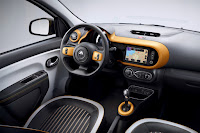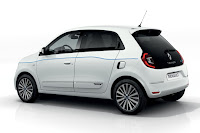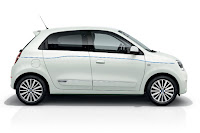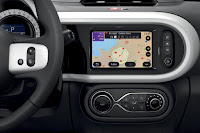Renault reveals the pure-electric Twingo Z.E.
As expected, the new Renault Twingo Z.E. is pretty much identical to the recently-launched and closely-related Smart EQ forfour.
Both of these small city cars have five doors, four seats and a rear-mounted electric motor which delivers 80 bhp (60 kW / 82 PS) plus 160 Nm (118 lb/ft) of peak torque. In the Renault, that output is sufficient for a 0-31 mph (50 km/h) time of around four seconds and an 84 mph (135 km/h) maximum.
There is one significant difference, though. Whereas the lithium-ion battery in the EQ forfour has a capacity of 17.6 kWh, the Twingo Z.E. benefits from a larger 21.3 kWh pack. Consequently, the latter’s driving range is better, as it achieves 111 miles (180 kilometres) on the WLTP Combined cycle and 155 miles (250 kilometres) on the WLTP City cycle.
Renault has fitted as standard an on-board charger that can handle AC currents of up to 22.0 kW. Naturally, replenishment rates vary according to the method used:
Like every other Twingo, the Z.E. version is built in Slovenia. However, like every other Twingo, the Z.E. version won’t be sold in the UK.
Related posts:
UK prices for the 2020 Smart EQ range
Upgraded 2020 Renault Zoe revealed
Return of the Renault Twingo GT
Both of these small city cars have five doors, four seats and a rear-mounted electric motor which delivers 80 bhp (60 kW / 82 PS) plus 160 Nm (118 lb/ft) of peak torque. In the Renault, that output is sufficient for a 0-31 mph (50 km/h) time of around four seconds and an 84 mph (135 km/h) maximum.
There is one significant difference, though. Whereas the lithium-ion battery in the EQ forfour has a capacity of 17.6 kWh, the Twingo Z.E. benefits from a larger 21.3 kWh pack. Consequently, the latter’s driving range is better, as it achieves 111 miles (180 kilometres) on the WLTP Combined cycle and 155 miles (250 kilometres) on the WLTP City cycle.
Renault has fitted as standard an on-board charger that can handle AC currents of up to 22.0 kW. Naturally, replenishment rates vary according to the method used:
- 2.3 kW domestic socket (0-100%) – 13 hours 30 minutes
- 3.7 kW dedicated wallbox (0-100%) – 8 hours
- 7.4 kW dedicated wallbox (0-100%) – 4 hours
- 11.0 kW public facility (0-80%) – 2 hours 10 minutes
- 22.0 kW public facility (0-80%) – 63 minutes
Like every other Twingo, the Z.E. version is built in Slovenia. However, like every other Twingo, the Z.E. version won’t be sold in the UK.
Related posts:
UK prices for the 2020 Smart EQ range
Upgraded 2020 Renault Zoe revealed
Return of the Renault Twingo GT







%2BDashboard.jpg)

+Front+Side.jpg)

+Front+Side.jpg)

Comments
Post a Comment